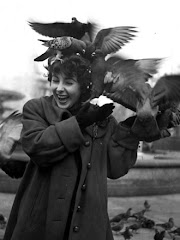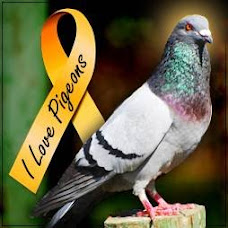By Hannah Holmes
Maybe the old ones never die. My Portland flock could be the self-same bunch of birds that filched clams from the Abenaki Indians and pooped upon approaching Viking boats. In addition to adapting flawlessly to the total nature-fake of a human habitat, maybe pigeons have also adapted perfectly to life: It doesn't make them die.
But because that's improbable, and because I was terribly curious about what kind of guy intentionally associates with pigeons, I called John Heppner, president of the National Pigeon Association.
"Absolutely," he said in a sobering tone of voice when I asked if there is such a thing as a baby pigeon. "I've been raising 'em for fifty years." What he went on to tell me gave me a new respect for the grubby, shining, strutting, victorious pigeon.
First of all, unlike dippy little English sparrows or robins, pigeons hide their nests.
Heppner said that back when they emerged in Asia (evidently, they were nature-living animals, once), pigeons were cliff-dwellers. So now they balance their messy nests of sticks inside the guts of bridges, or atop tall buildings, or on top of your air conditioner. Secondly, pigeons are parents non pareil. They lay only two eggs at a time, and spoil those babies shamefully. "The parents will feed the babies until they're totally feathered out," Heppner reported proudly. "By the time they leave the nest, they'll be about the same size as the adults. You know when people eat squab, that's when they take 'em -- when they're nice and plump." Squab, for the culinarily challenged, being baby pigeon.
And the doting parents don't feed these butter-balls your typical bird baby-food.
These birdlets get something called "pigeon milk," and the faint-of-stomach may not wish to explore this paragraph further. Both parents manufacture in their crop, or throat, a rich, fatty "milk" that looks, Heppner says, much like yellow cottage cheese. They ralph this delicacy up and expel it into the throats of their darlings. "You can see this white stuff glowing in the crops of the squabs," Heppner says. "They're just full of it."
After eight or 10 days of this ambrosial diet, the parents begin mixing in solid food and water. "They'll eat heavily, then drink a lot of water to easily chuck up the grain," Heppner enthuses, and offering between these fascinating facts to send me photographs of fancy pigeons. "And did you know pigeons drink like horses? Hens will lift their heads up to swallow. But pigeons put their head down and just take a long draught."
And do the parents flinch at all this work, this cheese-making, this grain-chucking, this drinking-like-a-horse? Of course not. "If all's going along well with the first nest, they'll build another, right near by, and lay the next batch," Heppner says. "They'll take turns sitting on the next set, while the other feeds up the squabs." And they'll do that four to six times a season. So, not only are there baby pigeons, there are baby-pigeon assembly lines.
And when the fledglings do finally leave the nest, Heppner says, their plumage and size are so similar to those of the flock they hang around with that only the practiced pigeonophile would be able to pick out the babies.
Care to practice finding the youngsters? Look for them in the spring and summer.
They may have stray strands of down poking through their feathers.
They may retain a trace of the "lip" around their beak that gives the parents a wider ralphing target.
Their heads may be narrower.
They may be shy. "They're more timid," Heppner explains. "They won't be professional in going after the best food."
So if you really want to see a baby pigeon, throw down a fried clam. That'll separate the men from the boys.
Monday, April 28, 2008
Subscribe to:
Post Comments (Atom)












No comments:
Post a Comment